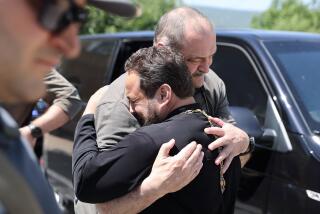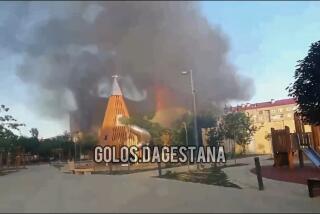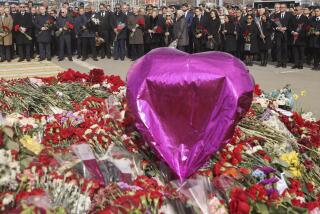Insurgents From Chechnya Seize 2 Towns in Dagestan
MOSCOW — Islamic fighters based in Chechnya led a bold incursion into southern Russia on Saturday, seizing control of at least two villages in the adjacent republic of Dagestan and raising fears of a return to wide-scale unrest in the unstable Caucasus.
Russian officials said the attackers drove and walked shortly after dawn over the thinly patrolled border dividing the separatist Chechen region from its mountainous, multiethnic neighbor and began digging trenches in positions around two villages.
Russia counterattacked with helicopter gunships, and battles continued throughout the day and into the evening. There were no immediate reports of deaths or injuries. However, much of the fighting was in remote territory where communication is poor.
Ethnic and religious tensions have been escalating throughout the summer in southern Russia. Russian and Chechen officials said the insurgents Saturday were Islamic militants, adherents of the Wahhabi sect, who want to spark an uprising, merge Dagestan and Chechnya, and found an Islamic state.
The officials said that most of the attackers were from Dagestan but that they included some fighters from Chechnya, Saudi Arabia, Uzbekistan and Tajikistan.
Lt. Col. Abdul Musayev, spokesman for the Dagestan Interior Ministry, said the fighters numbered about 300 and had encircled two villages in Dagestan’s Botlikh region--Ansalta and Rakhata--located a few miles over the border.
“Since we have not had any contact with the fighters, it is difficult to say what their goals are, what their tactics may be and how the situation will develop,” Musayev said by telephone from the Dagestani capital, Makhachkala.
Late in the day, Russia’s NTV network reported clashes between the insurgents and villagers, and said the fighting had spread to as many as four villages, including Echeda in the Tsumadi border region.
The Itar-Tass news agency, citing Dagestani officials, reported that the number of fighters could total 2,000 and that villagers had begun to flee the area in droves.
There were also unconfirmed reports that two warlords from Chechnya were involved: Shamil Basayev, hated in Russia for conducting hostage-taking raids that killed hundreds, and a Wahhabi field commander known as Khattab.
Russian officials said they were moving in OMON special forces--a kind of combination of SWAT police and the Green Berets--to help quell the unrest.
Between 1994 and 1996, Chechnya fought an inconclusive war to secede from Russia. The war gained the republic de facto independence but left it lawless, in ruins and awash with guns and fighters. Chechen leader Movladi Udugov said Saturday that the Dagestani insurgents were operating out of the control of the Chechen government.
“All attempts to blame the Chechen side . . . are completely unfounded,” Udugov said in a TV interview.
“However,” he said, “I am under the impression that the latest military and political processes we have been witnessing in the Caucasus may escalate into a full-fledged military conflict.”
Russia has been taking a more aggressive stance recently in the Caucasus region, reinforcing border patrols and bringing in thousands of additional security troops. Russian forces have been conducting preemptive strikes against suspected militants, and a clash in Dagestan last Monday left 11 people dead.
Russian Prime Minister Sergei V. Stepashin, who played a central role in the war against Chechen separatists, vowed Saturday that Dagestan will not become a second Chechnya and ordered the security forces to restore order with “maximum efficiency.”
“Bandits are bandits. And bandits must be treated accordingly,” Stepashin said. “We have the strength, and we have the means. I don’t see any other way.”
The threat of unrest in the Caucasus has raised fears among many observers that President Boris N. Yeltsin could use it as a reason to impose emergency rule. That would give the president a free hand against his political opponents as the country prepares for parliamentary elections in December and a presidential election in June.
Ever since the Chechen war, Dagestan has been a flash point of unrest. Unlike Chechnya, Dagestan is an ethnic patchwork, with at least 30 different ethnic groups, most with their own languages. The mountains near the Chechen border are particularly diverse.
Russian security officials blame Wahhabi militants for spreading strife in the impoverished region, where unemployment is said to have reached 80%.
The Wahhabis are a puritan branch of Sunni Islam founded in the 18th century in Saudi Arabia who follow a strict interpretation of Islamic law. Wahhabism rejects mystical practices, which puts it in conflict with the traditional form of Islam practiced in Chechnya and Dagestan, the Sufi branch.
Wahhabism arrived in Chechnya and Dagestan in the mid-1990s through missionaries from Saudi Arabia and locals who brought it home from pilgrimages to Mecca. It has since put down roots, not only in southern Russia but in some former Soviet Central Asian nations, notably Uzbekistan.
*
Alexei V. Kuznetsov of The Times’ Moscow Bureau contributed to this report.
(BEGIN TEXT OF INFOBOX / INFOGRAPHIC)
Dagestan
* One of the 21 Russian republics
* Makhachkala is the capitol and administrative center
* Area: 19,421 sq. miles
* Population: (1994): 1,953,000
* Industry: Petroleum and natural gas
* Religion: Islam
* Language: 27 are spoken
Source: Concise Encyclopedia
More to Read
Sign up for Essential California
The most important California stories and recommendations in your inbox every morning.
You may occasionally receive promotional content from the Los Angeles Times.










